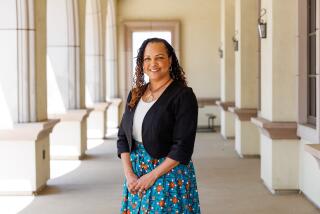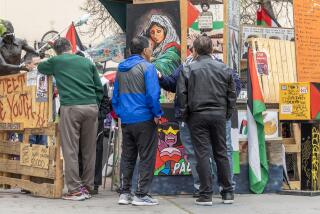For Graduate, Each Obstacle Is Really an Opportunity
My daughter, Dina, will graduate from Cal State Northridge on Wednesday.
“So you’re finally going to walk up there and get your diploma after eight years,” I teased her.
“If I could walk, Dad, I’d have done it in four,” she responded.
No doubt.
Dina has always seemed to have the perfect response--to a teasing line, a taunting playmate, an insensitive bureaucracy.
Although she has spent her life in a wheelchair after being born 25 years ago with cerebral palsy, she has demonstrated an amazing capacity for turning negatives into positives, obstacles into steppingstones.
Her mother, Annette, and I were thankful Dina even survived after she came out of the womb a shade of light blue with the umbilical cord wrapped around her neck. It was a full 20 minutes before she was breathing on her own.
We would eventually learn that brain damage had left Dina with weak muscle control on her left side and slurred speech. Doctors told us it was a miracle that, denied oxygen for so long, she was only affected physically, not mentally.
We taught Dina early in her life that she was not to use the word “can’t,” and she took it from there. When she was around 5, she was playing on a beach on Catalina Island with four kids she had just met.
“I don’t want to play with you. You talk funny,” said one kid. “Who doesn’t want to play with her?” he polled the others.
A second raised his hand.
*
Dina never flinched.
“Good,” she said. “You two can leave.”
She starting digging in the sand with the other two.
“Wait a minute,” said one of the kids who had objected to her presence. “I want to change my vote.”
So did the other. And soon, they were all playing together.
Dina’s positive outlook and winning smile earned her the role as poster child for United Cerebral Palsy, a role she filled for 10 years, appearing on telethons, in a movie, a television show and at various fund-raising events.
When asked for a school exercise to write about what was wrong with her life, Dina was the only one in her class to leave that question blank.
“I couldn’t think of one bad thing,” she told her teacher.
That all changed in junior high and high school. Her classmates, feeling the normal pressures of adolescence, sometimes took it out on her, mocking her and her limitations.
And school administrators didn’t make life easier.
At junior high in Woodland Hills she was given a locker on the top row rather than the bottom.
No problem, I figured. My wife and I went to the administration office and explained that my daughter was in a wheelchair.
“Sorry,” I was told, “that’s what the computer gave her.”
In high school, Dina was given classes on the second floor. Again, my wife and I went in to complain.
No problem. She could use the elevator.
Except that as a student, she wasn’t allowed to have a key to that elevator. So she would have to wait on the ground floor, sometimes for as long as 20 minutes into her next class, until a teacher with an elevator key happened to come along.
*
The school administrators made it clear from the beginning that they didn’t think it was advisable for Dina to remain at that campus because it was not equipped to deal with the disabled.
They changed their minds after she got five A’s in her first semester.
College presented new challenges. While her classmates were far more receptive and friendly than they had been before college, the workload was more intense.
Dina was forced to depend on either an aide or a classmate to take notes for her. One’s own hand-scribbled notes can be tough to read. Somebody else’s can be indecipherable.
Typing was also a problem. The only way Dina can work on a computer is to grip the top with her clenched right hand and hit the keys with her right thumb. It’s a slow, laborious process that limited her to two or three classes a semester.
She had to get up at 3 a.m. to reserve a van with a wheelchair lift to get her to class.
But Dina’s biggest school crisis came in the early-morning hours of Jan. 17, 1994. Like the rest of Southern California, she was awakened in fright by the Northridge earthquake. She had plenty to be frightened about. She woke up in her Northridge dorm in total darkness under a pile of books that had fallen off a shelf.
Understandably panicked, the rest of the students on Dina’s floor had raced from the building, leaving her and her roommate, Lisa, who is also disabled, to survive on their own.
Somehow, Dina found her electric wheelchair, crawled into it and, with Lisa in tow, navigated down the hall only to find the entranceway blocked by concrete debris.
To Dina, it was yet another steppingstone. She drove over the blockage and out into the breaking daylight with nothing worse than a sore neck. Lisa was able to climb over the rubble to safety.
Carrying on with her education, Dina also found time to become president of CSUN’s Disabled Students Organization. In that role, she campaigned for greater accessibility for the handicapped on campus while also working to involve the disabled more in campus life.
She even reaped some of the benefits of her own labor. When, after the earthquake, she found herself in a class located in a temporary hut, entered by stairs only, she mentioned it to DSO advisor Jim Hammitt. When Dina arrived for class the next day, a ramp had been placed in front of the classroom doorway.
With a major in child development, Dina, who is working as an intern at a UCLA medical clinic, hopes to continue her work with the disabled, specializing in helping handicapped children adapt to their world.
When the culmination of her college career comes on Wednesday, Dina wants to be regarded as just another graduate.
But when she wheels up to get her diploma, she will stand tall among her classmates.






